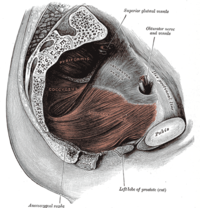
Photo from wikipedia
Synthetic midurethral sling (MUS) operations have become the current standard for surgical treatment of stress urinary incontinence in women. The retropubic tension-free vaginal tape was introduced by Ulmsten et al.… Click to show full abstract
Synthetic midurethral sling (MUS) operations have become the current standard for surgical treatment of stress urinary incontinence in women. The retropubic tension-free vaginal tape was introduced by Ulmsten et al. in 1996 [1], while the transobturator technique was introduced by Delorme in 2001 [2]. Thus, we have 20 and 15 years of accumulated evidence regarding these techniques, respectively. According to the latest Cochrane systematic review [3], the retropubic and transobturator procedures are associated with similar cure rates, both subjective and objective in the short term (≤1 year), the medium term (1–5 years), and even in the long term (>5 years). The relative risks vary between 1 and 0.95. The question, however, is whether these data provide a trustworthy description of efficacy in terms of durability of the MUS placed using the two procedures. A recent study based on a complete 10-year national registry cohort of 8,671 women showed reoperation rates after 5 years for the retropubic and the transobturator approaches of 6% and 9%, respectively. A Cox regression analysis revealed that the relative risk of reoperation after the transobturator procedure was twofold higher than after the retropubic procedure, a difference that was statistically significant [4]. The strength of these results is in the robustness of the information, since data reporting is compulsory for all hospitals according to Danish law and data completeness is above 90%. Similarly, a recent report based on available National Health Service data in Scotland relating to 4,628 retropubic tape procedures and 4,850 transobturator tape procedures concluded that Bbeyond 12 months there is a substantially greater need for repeat SUI-surgery following the transobturator approach^. Consequently, only the retropubic tape procedure is recommended for the surgical treatment of stress urinary incontinence [5]. Adding to the two national cohort studies the recent Cochrane review showed, that the relative reoperation rate after 1 year was 1.64 higher following the transobturator procedure, but the difference in the rates was not statistically significant. However, in the two medium-term studies and the four long-term studies the reoperation rates were 21.89 and 8.79 times higher, respectively, after the transobturator procedure, and the difference between these rateswas significant [3]. All six studies pointed in the same direction. Finally, a recent systematic review and meta-analysis of retropubic versus transobturatorMUSprocedures in patients with Bintrinsic sphincter deficiency^ showed a lower subjective cure rate in the short/medium term and a higher reoperation rate in the long term after the transobturator procedure [6]. Thus, the transobturator approach may be especially inferior in patients with a weak closure mechanism (sphincter deficiency or poor support). Thus, accumulating evidence clearly indicates that the reoperation rate is significantly higher and hence slings placed are significantly less durable with the transobturator approach than with the retropubic approach. Urethral slings work by creating midurethral support, and taking all the evidence together it is reasonable to state that slings placed using the retropubic approach are more durable, especially in women with a poor closure mechanism, since the forces created by a sling in a more horizontal direction are significantly lower than the forces created by a sling in a vertical direction [7]. This biomechanical concept is supported by clinical data showing that the retropubic approach is better * Gunnar Lose [email protected]
Journal Title: International Urogynecology Journal
Year Published: 2017
Link to full text (if available)
Share on Social Media: Sign Up to like & get
recommendations!